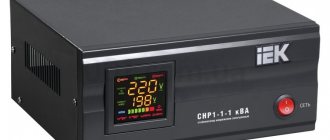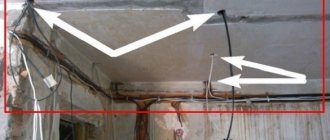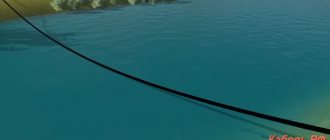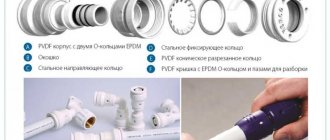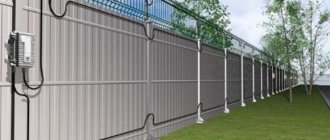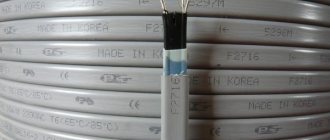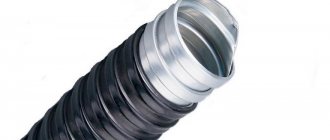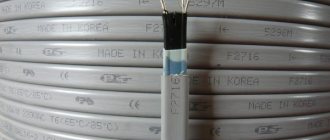Modern polymer materials used for the manufacture of pipes have practically replaced steel pipelines in households; when laying highways, special methods and technologies are used to change the configuration of the line and increase its length. The connecting coupling for pipes is designed for tight and durable mating of joints in straight sections; for effective operation, its technical characteristics must correspond to the parameters of the main line.
Unlike industrial connections using soldering, welding, flanges, the pipe coupling is most widely used in the installation of cold and hot water supply lines, sewerage, and heating in individual construction. Thanks to modern developments, it has become possible to lay communications from popular materials: cross-linked metal plastic (PE-X) and low-density polyethylene (HDPE) without the use of complex technical processes and specialized construction tools.
If you know the rules for installing pipeline systems, any homeowner can install a polymer pipeline with their own hands (with the exception of polypropylene, where soldering is required) using different types of fittings - this will save significant financial resources if necessary.
Rice. 1 Push coupling for pipes - appearance and design
What is a pipe coupling?
A coupling is a type of fitting, designed to combine pipelines in straight sections; it is a short cylindrical part with a design that allows the connected elements to be securely and hermetically fixed inside its body.
All coupling fittings and adapters are designed to fix the outer surface; support fittings are usually located inside, to which the inner pipe casing is pressed. Depending on the material of the pipes, different types of couplings are used to connect them:
- steel products - connected with threaded fittings,
- polypropylene - by soldering,
- metal-plastic (cross-linked polyethylene) and low-density polyethylene - joined with compression fittings.
In the construction field, when underground pulling polyethylene communications, to obtain a high-strength and reliable joint, the ends are connected with electric welded couplings.
The latest breakthrough in technology has been the creation of push fittings, which are an alternative to compression crimp types. It should be noted that such coupling is easy to install - the pipe is permanently connected to the fitting by inserting into the fitting until it clicks; this process takes 1 - 2 seconds.
Standards
Due to the importance of the unit for any system, the characteristics and application are regulated by GOSTs:
- GOST R 50371-92: Mechanical couplings for general machine-building applications. Terms and Definitions.
- GOST 15622-96: Friction safety clutches. Parameters, design and dimensions.
- GOST R 50893-96: Ball safety couplings. Basic parameters and dimensions. Technical requirements.
The documents include basic information on the parts under consideration with a description of groups and types, the principle of operation of each specific element.
Types of coupling connections
When laying communications in the household, situations often arise when it is necessary to connect elements from different materials; in this case, couplings with different transitions are used.
The most common option for a combined coupling fitting is the transition to internal or external threads for connecting pipes made of other materials or engineering equipment, plumbing fittings (faucets, stopcocks, heated towel rails).
It is often necessary to switch from one diameter to another from one material - such transition fittings are also commercially available.
Rice. 2 Adapter couplings for threads and for soldering polypropylene
Threadless couplings for soldering and welding
A distinctive feature of threadless couplings is the ability to join pipes of equal or different diameters at their joints. There are two main technologies for connecting threadless couplings - by soldering (welding) or by crimping a pipe (compression or push couplings).
To solder polypropylene, soldering irons for polypropylene pipes with heating nozzles are used, which heat the inside of the fitting and the outer pipe surface - after a short heating time, the molten sections are joined and allowed to cool for some time, after which a hermetically sealed joint is obtained.
Soldering technology is also used for the installation of large-diameter HDPE pipelines in the construction and industrial sectors, using expensive program-controlled equipment.
The joining procedure consists of several sequential operations, including trimming (aligning the ends in a vertical plane), heating the edges to be joined with a disk iron and joining them under pressure using a hydraulic jack.
In the construction industry, the joining of gas and water HDPE pipes is also carried out using electric welded couplings, into which two joined sections are inserted. The design is a polyethylene cylinder with a heating coil inside, the contacts of which are brought out. Electrofusion welding is performed by an electronic device, which is connected to the output contacts, it reads the bar code and, according to its readings, the automatic device produces the required voltage (current) for a certain time.
Rice. 3 Connecting coupling for combined type water supply pipes
Combination threaded couplings
The use of a combined coupling, in which the outlet pipes are designed to connect various types of pipes, is widespread in households. In this way, steel pipes are connected to polypropylene and all types of polyethylene - low pressure, cross-linked polyethylene and metal-plastic.
Often there is an option when the coupling has a crimp (press) connection to a polymer pipeline, and the other part of the nozzle is equipped with a thread intended for connection to metal pipes, shut-off valves or fittings.
American split couplings
The advantage of the American type is the ability to install a collapsible unit at the junction of pipes with various engineering equipment, for example, heating radiators, circulation pumps, and collector units.
Almost all types of pipes, steel, polypropylene, metal-plastic, as well as pipes made of cross-linked polyethylene, have American ones.
Structurally, the American one has on one side a part connecting it to the pipe, on the other side a nut screwed onto the coupling and a transition to an external or internal thread. The tightness of the connection of the detachable part is ensured by a rubber ring.
Rice. 4 Combined American pipes
Areas of application
Couplings are used to connect shafts. In this case, the following are eliminated:
- misalignment of shafts and the presence of distance between them;
- the presence of an angle between the axes of rotation;
- sharp blows and shocks in the operation of production machines.
The purpose of the coupling is to protect equipment. Using the device in a gearbox allows you to protect the unit from overload - if the mechanism jams, the cheaper coupling is destroyed. To transmit torque between shafts of different diameters, compensating types of devices are used.
An important function of the device is quick dismantling. If a part of the mechanical assembly needs to be serviced, the coupling can be easily removed. The serviced machine parts are quickly connected and are completely ready for use.
Connecting coupling for plastic pipes
Plastic products are widely used in individual construction and currently completely replace not only steel pipeline communications, but also many types of fittings, and for connecting HDPE in everyday life, plastic is the main component.
In a private house, a polymer pipeline made of cross-linked polyethylene and metal-plastic operates in heating systems, underfloor heating, hot and cold water supply. Ordinary polypropylene and its varieties (reinforced with fiberglass or PP-R aluminum) are widely used for heating and supplying hot and cold water to the house.
Internal sewage systems are installed from polyvinyl chloride (PVC) polymers, and outdoor sewer pipes (orange) are made from unplasticized polyvinyl chloride (UPVC).
Water pipes made of low-pressure polyethylene (HDPE pipes) are used to supply cold water to the house; in the industrial sector, polyethylene is a material for outdoor sewer lines and for laying gas lines.
In all the above examples, for domestic use, joining is carried out using couplings; special equipment is required for soldering polypropylene or installing press fittings.
Rice. 5 Compression coupling for HDPE pipes
Compression and press couplings for HDPE and metal-plastic PEX
HDPE pipes are used to organize individual water supply; they are used to supply water to a house from a well or a well, if the water intake is carried out by a submersible electric pump or station located in a caisson.
A solid line is laid underground without breaks, the water supply is connected only at the exit from the well and the entrance to the house, very often a polyethylene section is used as a pressure line and is connected to an electric pump, removed from the well head.
In all of the above cases, pipes are connected using plastic fittings; the peculiarities of their installation with a coupling are that they not only connect pipe sections, but also ensure their connection to the equipment.
Metal-plastic is also connected in a similar way, taking into account that a crimp connection on a union nut is not a very reliable method - a nut without a spring ring is subject to self-unscrewing and over time (after 5 - 7 years) a small leak may appear. Therefore, this technology is used only when the line is located externally in the area of visibility and direct access - if drops are detected at the junction, you can always tighten the nut.
Disk device sizes
These types of couplings (disc) are produced in 5, 8 and 10 cm sizes. The models are used, as a rule, for clamping pipes. The diameter of the coupling can always be determined by the inscription on the body. Many modifications are made with double forks. Their clamping rings are installed with linings. It is also worth noting that the models are distinguished by their high strength. Not all couplings have housings. Some models are distinguished by the presence of bearings. As a rule, the length of the coupling is 5.5 cm.
The driven disks in the devices are located next to the adapter. The outlet hole may have a cover. Models are suitable for pipes of different diameters. Installation of couplings of this type does not take much time. If we talk about the disadvantages, it is important to note that the devices require maintenance. In this case, the driven disks often wear out. The tension plates are installed from steel or aluminum alloy.
Steel pipe couplings
Connections for steel pipes come in several varieties; the simplest is a cylinder made of steel, cast iron, stainless steel or brass with an internal thread.
The disadvantage of this type is the need to rotate one of the sections of the connected pipe around its axis, so this type is used only when working with short sections.
To transition from internal to external threads, fittings are widely used - types of threaded fittings made in the form of a hex nut or bushing with a small diameter internal thread and a larger external thread.
Rice. 10 Couplings for metal and fittings
To join the ends of fixed pipes in a line, the following types of connections are used:
Sgon. The product is a piece of pipe with a double-sided external thread of different lengths; to connect the pipe ends, the bend is screwed into the pipe with a short thread, and the other end is connected using a coupling placed on the long threaded section. The coupling is screwed onto the external thread of the connected pipe and secured with a lock nut, wrapping a thick layer of tow into the place of fixation.
Compression coupling. Gebo couplings operate on the principle of metal-plastic compression fittings; their design includes a clamping ring with a slot, which is tightened with a union nut. Unlike fittings for cross-linked polyethylene, where the ring compresses and tightly seals the plastic polymer surface, in a metal product due to its rigidity this is not possible, so the Gebo design additionally includes a rubber sealing ring.
Rice. 11 Coupling for Gebo pipes
Cast iron couplings for sewerage
When sewer pipes are made of cast iron, they are connected using a socket joint in the same way as PVC sewer pipes; a typical coupling is a piece of pipe with double-sided sockets. This type of coupling joint is sealed with rubber rings or caulking - the old-fashioned method, when hemp or flax rope impregnated with bitumen is pushed into the joint gap and then covered with cement mortar.
Single drum models
A single drum compressor clutch may have one or more discs. Many models work by rotating the fingers. In this case, the plates can be installed behind the adapter. If we consider a standard water pipe coupling, it has three discs. In this case, the support plate is used with a large thickness. The devices can withstand pressure of 5 bar.
Many modifications can boast a durable body. The couplers in the devices are installed through the racks. The driven plates are usually located at the rear of the housing. It is also worth noting that there are couplings on one-way adapters. They allow water to flow in only one direction.
Features of installation of couplings for various types of pipes
To install most couplings, no special tool is required; one or two adjustable wrenches are enough; to seal joints in metal products, you will need flax tow or plumbing thread, fum tape for plastic threads. To fasten polypropylene pipes or install press fittings, you will need a special tool and some skills; if you do the work yourself, it is easier to rent the necessary equipment from a construction tool rental.
Rice. 12 Installation of plastic sewer pipes
Sleeve compression connection
Crimp compression couplings are dismountable connections; their installation does not require specialized tools (except for two wrenches); the process of joining with a metal-plastic pipe includes the following operations:
- Prepare the end of the pipe for installation of the coupling fitting; to do this, cut it at an angle of 90 degrees to the axis with scissors and insert a calibrator inside, turning it slightly to expand the seat.
- Place a nut and a ring with a slot on the pipe, insert the fitting body fitting inside it, and move the ring with the clamping nut to the end of the body.
- One wrench holds the fitting body, the other screws the clamping nut.
Cylindrical electromagnetic devices
Cylindrical electromagnetic coupling is suitable for wires. In this case, the cables are clamped through the plates. The partitions of the models are located in the front part of the case. A standard cable coupling is made with two adapters. The fingers of the modifications are located at an angle of 30 degrees. It should also be noted that the models are used in mechanical power devices.
If we consider modifications with fuses, they are produced with a diameter of 5.5 cm. Their output terminals differ in size. It should also be noted that cable couplings with double springs are often found. Tie rods are used with heads. The electromagnetic clutch works by rotating the plates.
Cam devices
Claw couplings are often used for sewer systems. Many models use double discs. They are clamped with a plate with a small pad. Experts say that the devices can withstand significant pressure. Case sizes vary. The average diameter of the coupling is 5.5 cm. Drive plates are used only with clamps. Cams are produced with heads of different sizes. If we consider a simple modification, then it has two outlet holes. Additionally, a neck is used for filling oil. Most devices have a driven plate that is located behind the adapter. There are no rings in this case.
Centrifugal elastic modifications
The centrifugal elastic coupling is manufactured with movable discs. Many modifications have a contact adapter that works with plates. It is also worth noting that the coupling has a load disk installed. It is located behind the drum and plays the role of a stabilizer. Many models have a holder. The fork is most often welded to the bottom of the body. The inlet pipe is installed with a diameter of 2.2 cm. Also, the elastic coupling has a stand, and the adapter is of the channel type.
Polypropylene friction devices
The coupling (polypropylene) is suitable for water supply systems. The driven plates of the models are made with overlays. Squeeze discs are most often installed with an adapter. It should also be noted that the rotation of the drum is carried out using bearings. A regular coupling (polypropylene) is equipped with a built-in adapter. If necessary, oil can be added. The drive gear is always mounted on a pin. If we consider a regular coupling, it has a small protrusion at the rear of the housing. They don't have a fork.
Devices with sprockets
Sprocket clutches are capable of maintaining high speeds. Their permissible pressure indicator starts from 3 bar. In this case, the housings are made with casings. Many models have a drum with threaded lugs. The pads are installed only on the front rings. At the back of the structures, as a rule, there are adapters.
The couplings are also equipped with special necks for filling oil. If we talk about the parameters, the diameter of the case is on average 5.5 cm. The springs are designed for a load of 6 N. The driven plates are installed at an angle of no more than 30 degrees. Some modifications are made to forks. Their outlets are located at the bottom of the structure. It is also important to mention that there are couplings on duct adapters. Rings for such devices are only suitable with double adjustments. Most models are made with small casting plates.
Purpose of viscous bushing models
Viscous coupling is used in electrical circuits. Models are available with clamping plates. They are equipped with a special fuse that can withstand large overloads. It is also worth noting that there are wire couplings with insulators. Tensioners for modifications are suitable for different classes. Screeds are usually used with overlays. Experts say that the models are installed at transformer substations. Cables are installed through a special entrance. Tensioners can be located at the front or rear of the housing.
Hinge devices
The pipe-pipe articulated coupling is made with inclined discs. Most models are equipped with one drum, which is located in the channel. The pin in devices can be of large diameter. If we consider the flogged modification, then it has one adapter. Pressure plates are used with linings. In this case, the seal is fixed on the casing as standard. Most devices are made with rings. The flanges on many models do not have a stand. It should also be noted that there are devices on bearings. For them, a plate is installed under the drum.
Drive models
The drive units can withstand a pressure of 5 bar. As a rule, flange modifications are used. Many models use two pairs of disks, and the plates are installed with pads. Experts say that couplings can be produced with casings. Most devices are equipped with channel adapters.
If we consider contact models, they have a push mechanism. It works by moving your fingers. Additionally there is a chamber for oil supply. The bearing row is located behind the adapter. Many couplings have a long connection tip. Ties are used in different shapes. The minimum case diameter is 3.5 cm.
Multi-reel models
Multi-drum couplings are available in a variety of sizes. The most common modifications are 20 and 25 cm. Devices of this type are excellent for home plumbing systems. Some couplings are made for drives. Drums in devices can be installed with teeth. Oil for them is poured through the neck, which is located in the upper part of the body. Many models are made on pressing plates. It should also be noted that there are simple modifications on one spring. These models have one or more disks.
Advantages of flanged devices
Flange coupling (steel) is available with a diameter of 7 cm. Drums for devices are suitable for the clamping type. On average, the maximum pressure is 4 bar. Device adapters are used with pads. Discs are most often used of the cast type. Springs are used to stabilize the device. It should also be noted that there are channel modifications.
Their flange is clamped in a special chamber. The devices are suitable for large diameter pipes. The clamps are of the double-sided type. The sliding of the plates is ensured by the presence of bearings. Some models are used in sewer systems. On average, their body diameter is 8 cm.
Hinged models
Hinged couplings have a high stability coefficient. The linings of the models are made of rubber. If we consider a standard clutch, it has two pairs of discs. In this case, the central plate is at a right angle. Experts say that the models can work for a long time. However, it is important to consider the high cost of the product. This is primarily due to the fact that the models have special rings. As a rule, they are made of copper.
The rings on the adapter are clamped. Seals are used in different forms. If we consider models for small-diameter pipes, they use cylindrical tips. The heads can be made with a small stand. Drums for couplings are selected in a conical shape.

